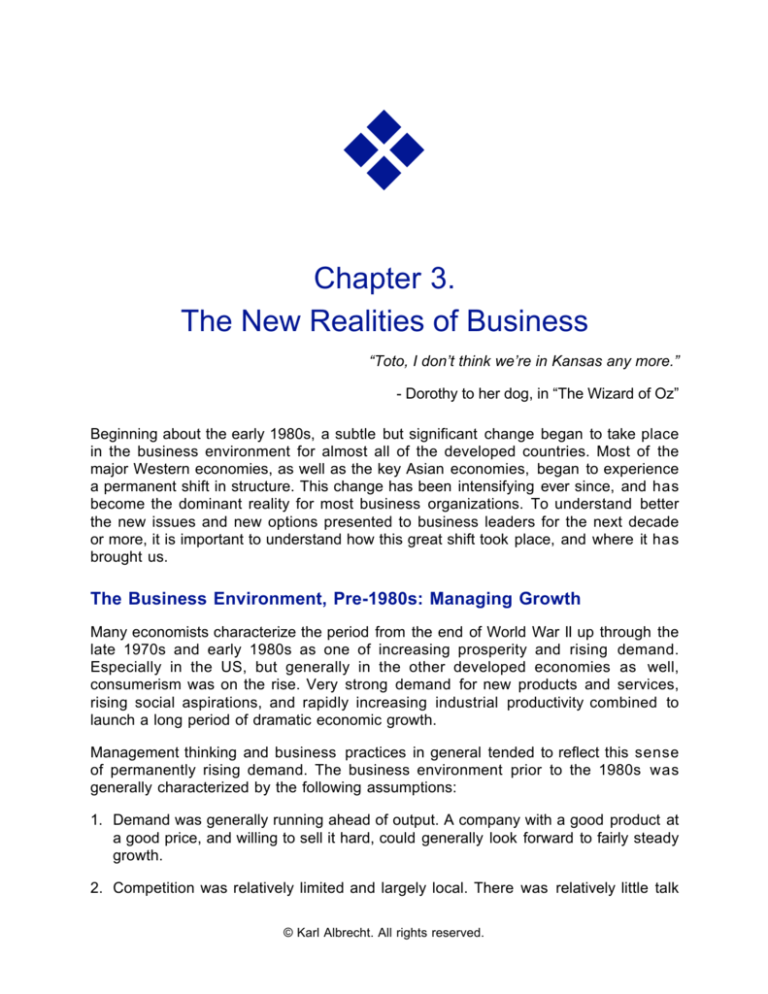
❖
Chapter 3.
The New Realities of Business
“Toto, I don’t think we’re in Kansas any more.”
- Dorothy to her dog, in “The Wizard of Oz”
Beginning about the early 1980s, a subtle but significant change began to take place
in the business environment for almost all of the developed countries. Most of the
major Western economies, as well as the key Asian economies, began to experience
a permanent shift in structure. This change has been intensifying ever since, and has
become the dominant reality for most business organizations. To understand better
the new issues and new options presented to business leaders for the next decade
or more, it is important to understand how this great shift took place, and where it has
brought us.
The Business Environment, Pre-1980s: Managing Growth
Many economists characterize the period from the end of World War II up through the
late 1970s and early 1980s as one of increasing prosperity and rising demand.
Especially in the US, but generally in the other developed economies as well,
consumerism was on the rise. Very strong demand for new products and services,
rising social aspirations, and rapidly increasing industrial productivity combined to
launch a long period of dramatic economic growth.
Management thinking and business practices in general tended to reflect this sense
of permanently rising demand. The business environment prior to the 1980s was
generally characterized by the following assumptions:
1. Demand was generally running ahead of output. A company with a good product at
a good price, and willing to sell it hard, could generally look forward to fairly steady
growth.
2. Competition was relatively limited and largely local. There was relatively little talk
© Karl Albrecht. All rights reserved.
about global commerce, global markets, and global competition, even in primary
industries such as oil, steel, and industrial commodities. Markets during that
period were primarily the home markets. Certainly exports were on the rise, but
most American products were designed primarily for the American market, with
export sales largely considered a bonus. Outside the US, it was more common for
firms to try to target their products to the American market, but the reverse was
seldom the case with American products.
3. Producers were, for the most part, in the driver’s seat. With rising demand and
falling production costs, many firms had little incentive to make radical increases
in product quality. Consumers generally had a few primary choices in each
category. Imported products were still relatively novel in America, in most cases.
4. Rising revenues were largely taken for granted. The assumption seemed to be
that, if we can keep our costs under control, keep increasing productivity, and keep
expanding our capacity, we can ride the sales curve to ever rising revenues and
ever rising profits. Most management books and courses implicitly dealt with the
management of growth.
5. Management thinking and energy was largely devoted to production issues, i.e. to
the operational systems in the organization that produced the product or delivered
the service. Customer demand was taken largely for granted, and the customer
experience was not generally considered a key element of the business formula to
be managed.
6. Cost-oriented strategies tended to parallel the production focus. The prevailing
management worldview, promoted by almost all well-known business schools,
represented the business as basically an apparatus, with resources and
processes to be managed. This was the age of “Industrial Management.”
The Business Environment, Post-1980s: Hyper-competition
Somewhere around the turn of the 1970s decade, the consumer growth boom began
to top out, as the post-war baby boom generation began to mature past their
intensive-consumption phase, birth rates began to decline, and people found
themselves in possession of many of the things they had desired. Management
thinking and business practices have been characterized by the stress of adapting to
this changed reality:
1. Output began running ahead of demand. While demand was leveling off, the
steady flow of capital invested in new production capacity in a wide range of
industries created world overcapacity in many industries and intense pricing
pressures.
2. Competition became more intense and much more global. With falling trade
barriers, a strong dollar, and a quality revolution in Japan, the US experienced
CR03-2
unprecedented levels of imports, at lower prices than many American firms could
charge. Japanese firms virtually took over the market for consumer electronic
products, and began to make serious inroads into the US car market. At the same
time, many of the larger American firms began expanding aggressively overseas,
and branded fast-food products such as McDonald’s hamburgers and Coca Cola
began adding to the influence of Hollywood films in exporting the American culture
to all parts of the globe.
3. Customers were now in the driver’s seat. With imported products from weakcurrency countries under pricing those of the richer economies, consumers
became more comfortable buying foreign-made products. Adding to the continuing
oversupply of home-built products, this provided consumers with unprecedented
buying power. The early- and mid-1980s saw a steady rise in price wars among
car sellers, airlines, appliance makers, banks, insurance companies, fast food
merchants, and many others.
4. Revenues became increasingly uncertain. The steady-growth assumption came
under intense fire as each recession did proportionally more and more damage to
profits. “Diversification” was no longer the magic word for profit-building. As
competition became ever more intense, many firms discovered the hard way that
trying to invade markets in which they had no special advantages could be
unhealthy for shareholder value.
5. Management thinking and energy began to shift from an internal focus, i.e.
production issues, to an external focus, dealing with marketing, customer
perception, and the selling of value.
6. Value-oriented strategies began to dominate. The “customer revolution,” arising in
the early 1980s, captured the attention of many executive teams, as a concept for
differentiating their companies from their competitors. A more intense focus on
understanding the customer’s conception of value, and focusing the energy of the
organization on delivering it, replaced the previous attitude of taking the customer
for granted. This became the era of “Service Management.”
Price Wars and Collective Suicide
The shift from the “demand” economy to the “push” economy and the rise of hyper
competition in almost all sectors have given us an ugly and permanent truth:
the competitors in a crowded market tend toward
collective suicide.
To see how this works, consider Figure 3-1, which shows how the competitive
dynamics shift as an industry, sector, or product moves through its market life cycle
from infancy to maturity.
CR03-3
Market Life Cycle
Developing
Maturing
Saturating
Suppliers:
Innovators
Imitators
Predators
Differentiation:
High
Decreasing
Minimal
Dynamic:
Evolution
Positioning
Price Wars
Figure 3-1. Product Evolution and Competition.
Developing Stage. When the market is new or developing, the competitive picture
tends to be confused and unsettled. Suppliers have to innovate because there is not
yet an accepted definition of what the product should look like. Competitive
differentiation is high because each of the suppliers is searching for a winning
solution. The basic competitive dynamic of this type of market is evolution toward a
value package that the customers will respond to most enthusiastically. The early
days of the personal computer and PC software saw this chaotic, formative state of
affairs in the market. The World Wide Web went through much the same process on
its way to commercialization.
Maturing Stage. As more and more competitors offer a wider range of choices, the
customers vote with their purchases and certain kinds of value packages succeed
while others fail. The surviving competitors quickly gravitate toward a narrower range
of choices, and a particular “style” of the product or service emerges as the preferred
design. At this stage, most of the suppliers become imitators. Differentiation
decreases radically and the competitive dynamic becomes a matter of positioning, a s
competitors ply the customer with their favorite variations on the core design. Virtually
all new products and services pass into this maturing stage. Automobiles now tend to
look and operate just about the same, with various cosmetic differences. Even
clothing designs gravitate toward basic structures, with stylistic variations. Personal
computers have looked basically alike for a long time. The Internet has not yet passed
completely into the second stage.
Saturating Stage. Once too many competitors have discovered a product or service
and a core design has evolved, the market becomes a shoving contest, with
competitors elbowing one another for a better shot at the customers. Innovation is
virtually nonexistent, or at least seldom emphasized. Differentiation is limited to the
standard choices that have emerged, such as price range, feature sets, or style
variations. At the saturating stage, market share gets divided thinly, profit margins fall,
and more competitors battle for the available revenues. Inevitably, one or more
competitors, usually the larger ones, will start a price war with a predatory pattern of
CR03-4
discounting and price-cutting in hopes of gaining market share by forcing others out of
the game. For example, the personal computer is now a fully commoditized product,
subject to fierce competition and enriched only by price-related feature options. The
Internet went into the price war stage in record time, as self-styled marketing experts
began to slash prices on Internet access almost as soon as the phenomenon
became popular. Indeed, this “giveaway” mentality has probably doomed the Internet
to the permanent status of a no-profit zone.
The movement of any product, service, industry, or sector through these three stages
is almost inevitable. The competitive forces moving all players from innovation to
cutthroat competition are almost irresistibly strong, like gravity pulling them down a
slippery slope into the mud. When the product or service has lost all or most of its
variability, and all suppliers look just about alike to the customer, then the customer
gets to the point where he or she has no rationale for choosing one supplier over
another except the lowest price.
Price wars tend to be rampant in mature industries such as airlines, retailing, and fast
foods, as all players drift into a kind of collective suicide pact. Even those who try to
resist giving away their gross margins feel the pressure as others slash prices below
the point of profitable operation. It is sometimes said that, in a price-driven business,
you’re no more successful than your dumbest or most desperate competitor. In a
number of saturated industries, well-capitalized mega-firms have jumped in, adding
excess capacity and trying to buy customers with subsidized pricing. Like the big kid
who cannonballs into the swimming pool, they make a big splash, annoy everyone
there, and chase the smaller kids out of the pool.
The few firms that resolve to separate themselves from the self-destructive price wars
usually find it very difficult. If virtually all of the suppliers in a particular line of business
have spent years conditioning their customers to perceive price as the only variable
that counts in their purchases, a maverick firm must find a way to offer genuinely
superior value, make its message believable to enough customers, and work hard to
help them perceive the difference. Years of commercial experience have shown that
most customers will quickly gravitate toward the lowest price if they cannot detect a
significant and believable difference in the value being offered. Regaining a valid level
of differentiation in a saturated industry can be a very daunting challenge, although
potentially very rewarding to the firm that can pull it off.
Points of Inflection
Intel chairman Andy Grove’s concept of points of inflection involves a subtle but
profound proposition: we must detect — or at least infer — the beginnings of major
shifts in the business environment as early as possible, so we can position the
enterprise to deal with them when they arise. Waiting until a trend becomes obvious
means you probably won’t have the range of options for reacting to it that you would
have if you’d seen it coming. And your competitors will surely be reacting to it as well.
To Grove’s way of thinking, a point of inflection, or “flex point,” is an early warning
CR03-5
signal that can start you thinking.
What is a point of inflection? Grove has borrowed a concept from mathematics, but we
don’t have to delve into mathematical discussions to appreciate the value of the
metaphor he is using. A point of inflection is a change in a change, or more
specifically, a change in a trend.
For example, while government spending on defense may be increasing, each year’s
increase might be proportionally smaller than the one before. In other words, there i s
a slackening in the upward trend. If the rate of growth in the spending keeps declining,
then at some point the rate of growth gets to zero and goes negative; spending will
stop rising, level off, and eventually begin to fall. Figure 3-2 illustrates this inflection
point, i.e. the point at which the trend begins to reverse itself.
Figure 3-2. The Point of Inflection
To use an analogy from personal experience, suppose you’re driving your car up a
hill. If the hill has a uniform upward slope, you can hold the accelerator pedal at the
same point and the car’s speed will remain constant. You’re on a constant upward
trend, in this case in your altitude above sea level. Every additional mile you drive adds
the same amount to your altitude as the previous mile.
Now suppose you sense that the hill begins “leveling off.” The car demands less and
less gasoline to maintain its speed. You’re still gaining altitude, but now each
additional mile adds less altitude than the previous one. You’ve passed through an
inflection point. Your altitude is still on an upward trend, but the trend itself i s
decreasing. If the slope of the hill keeps decreasing, you will eventually stop climbing,
pass over the top of the hill, and begin going downhill.
This explanation could sound a bit tedious to some, but it encodes a very subtle idea.
You don’t have to wait until a trend completely dies, or reverses itself, to know
CR03-6
something is going on. By watching changes in the trend itself over time, you might
spot a point of inflection that could signal that the forces driving the trend are getting
stronger or weaker.
Chairman Grove applies the concept of the inflection point to the growth of his
particular business, the semiconductor industry. To him, an inflection point is any
point in the lifespan of a product, a company, or an industry that marks a change in its
destiny. Just about all products that contain microchips have been on strong upward
trends for about twenty years, with occasional short term variations. Presumably, this
kind of trend should give Grove plenty of cause to sleep peacefully.
However, to paraphrase Grove, “The seeds of our destruction could be germinating at
this very moment. Some new twist in chip design or manufacturing, or even some
totally new concept for managing data might be getting started in some garage or
research lab right now. If it is, we’d better be able to see the first signs of its effects
before anybody else does, including our customers. There may be certain subtle
signals in the marketplace or the technical environment that tell us the long-running
success story of silicon is about to change.”
Every executive and manager needs to watch for the points of inflection in his or her
industry. What signals might you be receiving from your business environment that
could tell you the fundamental forces are changing? Consider some lines of
business that might be overdue for change.
For example, the fall of the Berlin wall certainly marked a point of inflection for firms
involved in the defense industry. It became obvious very soon that the major world
powers would be investing less in weapons development and scaling back on their
standing forces. It also gradually became clearer that the huge investments in
technologies used for warfare would be redirected to other purposes. Satellite
technology, for example, stood to be refocused on communications, data
transmission, and space research, and less on surveillance. Computer and
telecommunications technology, as used in defense, has been refocused on “cyber
terrorism,” i.e. the use of information technology to attack national and military data
systems.
Some experts contend that a point of inflection for the old-line investment brokerages,
on Wall Street and elsewhere, was the arrival of on-line brokers on the Internet. A
fundamental change in the technology and economics of buying and selling stocks
could certainly present serious threats to the established structure of the securities
industry. It could also radically change the role definition of the stockbroker. No one
knows for sure how this development will unfold, but it certainly deserves careful study
by those affected.
Was the arrival of the personal computer a point of inflection for public education in
the US? Or would it be the arrival of the Carnegie Foundation report in 1983 which
pronounced American schools fundamentally unable to meet the needs of a modern
information-based society? Or was it the development of the World Wide Web and its
CR03-7
page-based structure for information? Which occurrence set loose the primal forces
of change that will threaten the existence of the American educational structure?
Perhaps all of them? Perhaps some other event that we haven’t quite recognized?
Long Waves, Short Waves, and Choppy Seas
Futurists nominate a wide range of trends as important in shaping commerce over
the next few decades. All of those trends deserve careful thought, even if not all of
them materialize. These include trends in international politics, economic changes,
ecological effects, changes in social values and structures, health trends, medical
procedures, technology, and issues such as crime and terrorism, to name just a few.
To lend greater focus to this discussion, however, I would like to nominate three basic
macro-trends, i.e. trends that incorporate other trends, for consideration in thinking
about the environmental scan. These three macro-trends are powerful almost beyond
belief, and they are intimately intertwined. They are:
Globalism. It has already become a cliché to say that all business is now global,
capital moves around in the world in a global network, all stock markets interweave
into a kind of global mega-market, and television news has made us all global
citizens, or at least spectators in a nightly global drama. Cliché or not, it is true. This
topic will receive much greater attention in later discussions. Business leaders need
to reach beyond the easy terminology of the cliché and explore the actual “dominos,”
or linkage mechanisms that create cause-and-effect relationships between far-away
events and their immediate businesses.
Cheap Information. Under all the hype and rhetoric surrounding the so-called
“information age,” digital technology, the Internet, and cyber everything, we can discern
one simple and powerful macro-trend: the abundance of cheap information. The
ubiquitous personal computer, combined with the declining cost of data transmission
technologies and the explosive growth of on-line or Web-based information
resources, means simply that information will become ever cheaper and hence ever
more abundant. Don’t be distracted by the preachings of the technopriests; the
technological gadgets they worship are merely a means to an end. Cheap and
abundant information is the state of affairs toward which we are all heading. And, by
the way, it will be a very mixed blessing, as later discussions will argue in more detail.
Deconstruction. One of the many labels one can apply to the period beginning in the
mid-1980s could well be the “age of paradox.” While one might expect a global
environment of culture and business to tend toward homogeneity of structure, views,
and values, exactly the opposite is taking place. Particularly in the US, but increasingly
in other countries, segmentation is becoming more pronounced. Social structures are
disintegrating. Corporations are delayering, outsourcing, downsizing, and demerging.
Mass markets are disintegrating into segments and sub-segments. Demographic
and psychographic differences are becoming ever more finely divided. Social, ethnic,
political, and gender factionalism are all rising. Even countries are coming unglued.
CR03-8
Attempts to create a “United States of Europe” are struggling with ever more
intensified national and cultural differences. We will explore this paradox of structure
in more detail later, but for this discussion it is important to point out that executives
must be more and more the managers of complexity.
❖
CR03-9
Chapter Notes (3)
1. Albrecht, Steven. Crisis Management for Corporate Self-Defense. New York,
AMACOM, 1996, p. 13.
2. For a thought-provoking view of global commerce, see Ohmae, Kenichi. The
Borderless World. New York: Harper Business, 1990.
❖
CR03-10

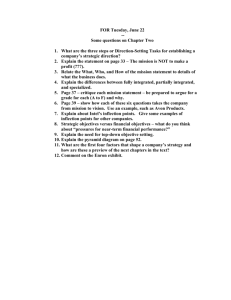
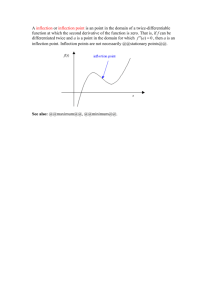
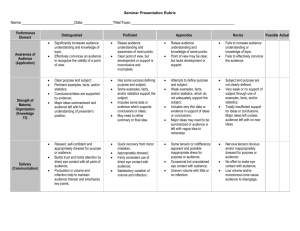
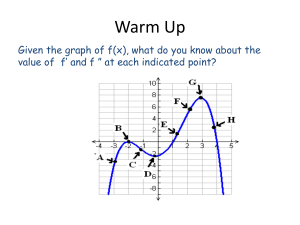



![Inflection points [4.2]](http://s2.studylib.net/store/data/005711558_1-7e6caa30b78ed23b978b40c18112cd02-300x300.png)

